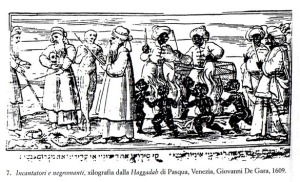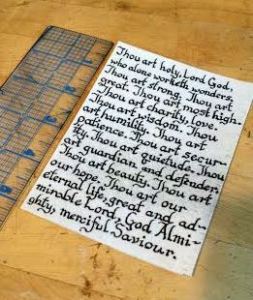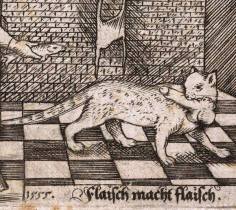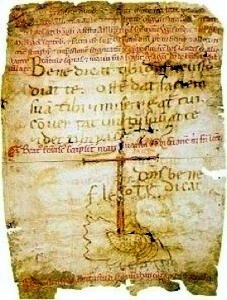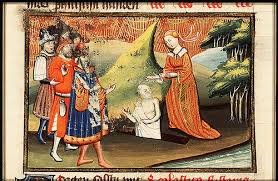Taken Out of Context – The Catholic Church’s Part in the Malleus Maleficarum
A papal bull is a particular type of letters patent or charter issued by a Pope of the Catholic Church. It is named after the lead seal (bulla) that was appended to the end in order to authenticate it. – Wikipedia
Innocent VIII: BULL Summis desiderantes, Dec. 5th, 1484
Innocent, bishop, servant of the servants of God, Ad futuram rei memoriam
It has recently come to our ears, not without great pain to us, that in some parts of upper Germany,……many persons of both sexes, heedless of their own salvation and forsaking the catholic faith, give themselves over to devils male and female, and by their incantations, charms, and conjurings, and by other abominable superstitions and sortileges, offenses, crimes, and misdeeds, ruin and cause to perish the offspring of women, the foal of animals, the products of the earth, the grapes of vines, and the fruits of trees, as well as men and women, cattle and flocks and herds and animals of every kind, vineyards also and orchards, meadows, pastures, harvests, grains and other fruits of the earth; that they afflict and torture with dire pains and anguish, both internal and external, these men, women, cattle, flocks, herds, and animals, and hinder men from begetting and women from conceiving, and prevent all consummation of marriage; that, moreover, they deny with sacrilegious lips the faith they received in holy baptism; and that, at the instigation of the enemy of mankind, they do not fear to commit and perpetrate many other abominable offenses and crimes, at the risk of their own souls, to the insult of the divine majesty and to the pernicious example and scandal of multitudes.
[severely redacted]
We therefore, desiring, as is our duty, to remove all impediments by which in any way the said inquisitors are hindered in the exercise of their office, and to prevent the taint of heretical pravity and of other like evils from spreading their infection to the ruin of others who are innocent……….. do hereby decree, by virtue of our apostolic authority, that it shall be permitted to the said inquisitors in these regions to exercise their office of inquisition ………….against all persons, of whatsoever condition and rank, the said office of inquisition, correcting, imprisoning, punishing and chastising, according to their deserts, those persons whom they shall find guilty as aforesaid.
And they shall also have full and entire liberty to propound and preach to the faithful word of God, as often as it shall seem to them fitting and proper, in each and all of the parish churches in the said provinces, and to do all things necessary and suitable under the aforesaid circumstances, and likewise freely and fully to carry them out.
The above words were written at a time when superstition and the concept of witchcraft and sorcery existed in Europe side by side as part of a cultural norm. The following two-hundred years would see those same concepts wrapped up together in an overblown and ugly way as unchecked fear ramped up and took hold of the culture and attitude around them.
Some attribute it to this Papal Bull and its appearance in a notorious book of the time, The Malleus Maleficarum written in 1487; a manual for the identification, prosecution, and punishment of those suspected of witchcraft, divination, and other (mostly imagined) offenses.
What many individuals forget is that the Summis Desiderantes was not written for the book nor intended as blanket permission for the Inquisition or church elders to torture and execute individuals that were suspected or rumored or biasedly accused without proper evidence of atrocities.
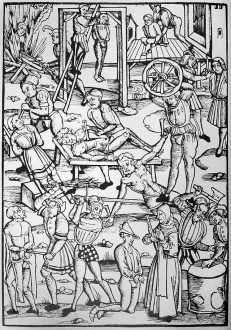
The history is this:
The bull was written in response to the request of Heinrich Kramer, an inquisitor in the Dominican order, for explicit authority to prosecute witchcraft in Germany. He had been refused assistance by local church and secular authorities, who stood by their decision that as the original letter of deputation for Kramer did not specifically mention where the inquisitors could operate, they could not legally exercise their duties as inquisitors in their [the local] areas. The bull had been requested to remedy this dispute by identifying individual jurisdictions, specifically the dioceses of Mainz, Köln, Trier, Salzburg, and Bremen.
Pope Innocent’s bull put into effect nothing new. Its direct purporse was to ratify the powers already conferred upon Heinrich Kramer (also called Henry Institoris in the Malleus) and James Sprenger, to deal with witchcraft as well as heresy, and it called upon the Bishop of Strasbourg to provide the inquisitors with whatever support was possible.
However, a short time later, Kramer published the book Malleus Maleficarum and used the wording of the Papal bull as a foreword. It gave the impression that the actions and thinking described in the book were condoned and supported by the Pope and the Church.
Neither was true as could be seen with the Inquisition denouncing Kramer in 1490 and the book being added to the Index Librorum Prohibitorum (List of Prohibited Books) in by Pope Paul IV in 1559.
Unfortunately, the damage was done. The book was reproduced and found in several corners of Europe and the “witch craze” was under way with the worst scenes to be found in Germany and France.
The Catholic Church had many official doctrines out that defined witch craft, sorcery, divination, etc as separate and unique practices. How to identify these individuals, counsel them, and punish only if they had broken secular or created heresy. The misrepresentation of the bull by Kramer created huge distrust and fear among folks who were formally neighbors and friends.
The damage was done and the ramifications were beyond what they could then perceive.
The complete wording of the the Papal Bull by Pope Innocent VIII can be found here.
Just a Hopeless (Nec)romantic – Necromancy vs Mediumship in Medival Judaism
Necromancy.
The Holy Grail of the realm of occult. As inspiring and elusive as the Arthurian legend; and like any legend, full of myths and misconceptions.
Rather that go on about what the practice of necromancy isn’t, let’s just stick to what it is; and *that*, ladies and gentlemen, is divination.
The practice of necromancy is primarily viewed throughout pre-17th century European cultures as a means of communication with a spirit for the purpose of answering questions of either the future or uncovering something of the past. The inherent good or evil of this practice depends on the culture in which it is taking place.
This is the first of a few articles on this topic. We will begin with just a brief insight into Judaic necromancy versus mediumship.
When I first started research in the area of medieval and ancient divination years ago, I looked at various links and citations to see what I could find. Sadly, no zombies. Curse you, Hollywood, and your inevitable betrayal! *shakes tiny fist*
However, I did hit the commentary several times that necromancy was disallowed in the Torah / Old Testament of the Bible . Citations included the following sections:
9. When you come into the land which the Lord your God gives you, you shall not learn to do after the abominations of those nations. 10. There shall not be found among you any one who makes his son or his daughter pass through the fire, or who uses divination, or a soothsayer, or an enchanter, or a witch, 11. Or a charmer, or a medium, or a wizard, or a necromancer. 12. For all that do these things are an abomination to the Lord; and because of these abominations the Lord your God drives them out from before you.
As has been taught: Or that consulteth the dead: this means one who starves himself and spends the night in a cemetery, so that an unclean spirit [of a demon] may rest upon him [to enable him to foretell the future]. And when R. Akiba reached this verse, he wept: If one who starves himself that an unclean spirit may rest upon him has his wish granted, he who fasts that the pure spirit [the Divine Presence] may rest upon him — how much more should his desire be fulfilled!
Here it is being stated via choice of words that the difference is in the intent of the practitioner and in the preparation for communication. “Starve” vs “Fast” is the main example. The starving is seen as an act of greed because the individual is forcing nature to get to their end goal. Whereas with fasting, it is structured and viewed as being part of meditation and readying oneself for the coming steps.
Another difference between the two styles is given by some of the Hasadei Ashkenaz, the leading German rabbis of the 13th century, who granted permission to consult the dead in particular cases. By their reasoning, a distinction was made between consulting with an actual dead body, which they forbade, *but* allowed for the consultation with a spirit.
Let’s get even more confusing about this. According to several rabbinical documents from the 13th century and earlier, the consultation with a spirit or listening to the conversations of the dead typically took where the dead dwelled; a cemetery. Someplace “unclean”.
Whereas, the consulting of a dead body could happen anywhere, but had restrictions. Most notably that the necromancer could see the spirit but not hear them. The querent could hear the spirit, but not see them. This leads to some accounts of where the person seeking out the ghost asks the diviner what the spirit looks like so they can tell if it is the right person. My favorite example is always the Witch of Endor who could see the ghost of the Prophet Samuel, but not hear him. When King Saul, in disguise, asked for a description of the ghost, the witch noted that the spirit had risen from the ground head first; this caused her to start in fright as she realized that her client must have been a great man or king.
Apparently, if you are just an everyday person, any spirit summoned for you to speak to would rise up from the ground feet first. Like some paranormal teddy bear being picked up by an ethereal child. I am not 100% clear on why this is the case. Will let you know when I do.
Getting back to the subject, in looking at the definition above (about 7 paragraphs now), one can tilt their heads and think, “Wait. Isn’t that mediumship?”; and you would be right.
Modern “psychic” mediums are those individuals that we think of when talking about seances around Halloween. Images of them sitting at a table, communicating with unseen forces and playing havoc with your electric bill while ghosts make your lights flicker.
Mediums and necromancers, in the Judaic culture at least, were very similar. They consulted the dead, but one by utilizing physical remains and the other by calling for the spirit. Talking in person versus texting. No, it isn’t a perfect analogy, but it gets the general idea across and that is what I’m striving for here.
The next in this series will deal with necromancy in Ancient Greek and Roman cultures.
Stay tuned!
1 Kuehl, Nancy L. Book of Evidence: The Trials and Execution of Jesus. Resource Pulications, 2013.
2 Trachtenberg, Joshua and Moshe Idel. Jewish Magic and Superstition: A Study in Folk Religion. University of Pennsylvania Press, 2004. Web.
3 Davies, Thomas W. and Lauron William, “Magic,” Black and White; Charms and Counter Charms. An epitome of “supernaturalism” magic, black, white and natural; conjuring and its relation to prophecy, including Biblicald Testamenl and Ot terms and words for magic. Chicago, Ill., De Laurence, Scott & co., 1910.
4 Jacobs, Joseph, and Ludwig Blau. “JewishEncyclopedia.com.” NECROMANCY
Cold Moon Rising
Here we are on the evening of December 25 and a unique celestial event has occurred.
A full moon.
Certainly a full moon is not unusual, but the timing of this one is somewhat unique. Not only does this full moon fall on Christmas Day, a holiday that has been celebrated around the world for centuries, but the last time it occurred was in 1977 and the next time it will happen again is 2034.
And it is because of those two distinctions that this “Cold Moon” has numerous superstitions and omens surrounding it.
For instance, it is said in old Italian tales that a halo around the Moon is an ancient sign of rain. The smaller the halo, the higher the likelihood of rain. If there are stars in the halo some omens say that it will rain for as many days as there are stars, others that the rain will come after so many days.
Some European cultures say that a full moon on this night is a predecessor of bad luck while others espouse that it is a bounty of good fortune.
Some Pagan beliefs cite that this is the time of the Morrigan, a figure from Irish mythology who sometimes takes the form of a crow or raven. She takes flight and visit folks and peer inside their dreams. Some say she brings warning of death from battle to those she speaks to. Others say premonitions of obstacles to be encountered in the coming year.
So, as a diviner, I have been requested to make my own predictions based on my observations of the full moon. This I do, by also considering all of the traditions I have encountered and the science that I know.
(NOTE: I am not a true practitioner or believer. I operate on the skills of observation and creativity that I have discussed in my various articles on this blog. Any “prediction” I present should be taken with a grain of salt and as pure entertainment only.)
*************************************
The temperature will drop and the cold shall continue for many weeks.
Storms shall greet us in abundance after the New Year.
This year will make its mark on many. Like a whisper of song in a forest. Or a midnight bell chiming calmly.
The West shall be the East and the East shall be the West.
Kingdoms will come together and rejoice.
One kingdom will weep.
A chartula by any other name……….. (Part 2 – The creating)
When last we left our intrepid adventurer, she had just provided a brief history behind the creation and use of the Chartula of Assisi.
In this post, I’m going to share with you how I crafted the piece. Please note, that what I did was not meant to be precisely 100% accurate, but close enough so I could understand better the thinking that went into the piece as well as the perceived mechanics behind it.
The base material of the piece, the vellum, was the easiest part to get my hands on. I had some scraps lying around from a previous calligraphy project. Fortunately, it only needed to be approximately 5 1/2″ x 4″ (the measurements of the original chartula), which I was just able to eke out.
The next bit was to understand the writing that was happening on each side of the vellum. The recto (the front/flesh side) and the verso (the back/hair side). Though the words on both sides are important in their meanings, the recto side had the specific prayer and the illustration, which were the parts to be meditated on as it was considered the more personal and, therefore, more potent side. In many cases, the recto side would be worn closest to the skin to ensure that it would have a better effect.
In the case of Francis, he wrote on the recto a 5-line benediction quoting Number 6:24 – 26: “Benedicat tibi Dominus et custodiat te/ostendat Dominus faciem suam tibi et misereatur tui/convertat Dominus vultum suum ad te et det tibi pacem.” which translates to “The Lord bless you and keep you; the Lord make his face shine on you and be gracious to you; the Lord turn his face toward you and give you peace.“
In writing it down, I could see how someone would be moved to say such things in hopes that these words could convey protection of a loved one. This falls under a practice found in modern fiction called “The Will and The Word”. 1 There isn’t a term that is a medieval equivalent, but it helps me with explaining the concept to a 21st century audience.
There’s a common saying that words have power. This has been shown in different ways in literature or thinkings for centuries. Meditation by way of saying a word or a sentence and picturing a corresponding image that has an emotional connection can generate calm or slow down one’s heart. A common belief in magic theory says that knowing an individual’s true (or complete) name gave the speaker some sort of control over them. When someone spoke an incantation they would need to hold an image of the effect in their mind. For example, saying “fire” and picturing the image of fire or flame in your mind made the spell more powerful.
In the case of the written talisman here, it worked by saying the word aloud or by saying it in your head, but, again, picturing an image or effect to focus on.
The image of meditation here is found in the drawing of the tau cross on the mound (possibly Golgotha?) with the head of Adam within. The cross accompanied a many of Francis’ letters over the years as a type of signature. 2 It is possible that the scene as a whole could be viewed as the focus to go with the words the friar wrote.
I will note here that my rendering of the cross on the mound is really not much like Francis’ depiction. However, neither he or I are artists and really, it’s the attempt here that matters.
On the verso, was written the Laudes, or praises of God. These are the praises as written by Francis himself of which
there are twenty-seven. Due to the size of my pen nib (modern Sheaffer pen), I managed twelve of the praises. I wrote them in English rather than their original Latin so that I could understand the words myself when I wrote them. Interestingly, I found it difficult not to consider each word and its meaning, alone as well as combined, with each stroke of the pen and then watching the ink dry into permanency.
I understand now that creating the piece may have been as much of a benefit to the scribe as it was to the recipient. The time, the patience, the construction, the creation, the presentation, the love it all bore. There was so much meaning and heartfelt intent in all of it that whether or not you believe in such things, the emotional intent much have been so strong and moving.
The recreation of the Chartula I did was started with no feeling or intent other than to satisfy my curiosity regarding my research in the piece. By the time I finished, it was much more as I felt a stronger understanding of why the piece was made and the manner it was fashioned.
So, at the end of it all, I didn’t want to keep the piece, but gave it to someone who I feel a deep friendship for and, because of his studies and beliefs, would have the appreciation to make this meaningful in the right way. Who knows, maybe I think the small piece of parchment would protect my friend for the rest of his days.
For my dear teacher and friend, Bruce Draconarius.
1 See The Belgariad series written by David Eddings
2 “The sign thau was more familiar to him than other signs. With it only he signed sheets for despatch and he painted it on the walls of the cells anywhere.” See Tr. de Miraculis, in Anal. Boll., t. xviii, pp. 114-115.
“We laugh because it’s funny….
…..and we laugh because it’s true” – Al Capone
******************************************************************************************************
I sat down recently in my living room and watched a movie that I had seen many times over the years. Funny, satirical, bawdy, crude, pratfalls. Everything that you could want in a comedy. There was something about what I saw, though, that tickled a feeling in the back of mind that I hadn’t expected.
To understand better, let me give you a foundation for what I’m about to discuss.
In the book Malleus Maleficarium, a late 15th century manual on witch hunting, there is an incident described about a man who had a shocking encounter with a witch.
In the town of Ratisbon a certain young man who had an intrigue with a girl, wishing to leave her, lost his member; that is to say, some glamour was cast over it so that he could see or touch nothing but his smooth body. In his worry over this he went to a tavern to drink wine; and after he had sat there for a while he got into conversation with another woman who was there, and told her the cause of his sadness, explaining everything. The woman was astute, and asked whether he suspected anyone; and when he named such a one, unfolding the whole matter, she said: “If persuasion is not enough, you must use some violence, to induce her to restore to you your health.” So in the evening the young man watched the way by which the witch was in the habit of going, and finding her, prayed her to restore to him the health of his body. And when she maintained that she was innocent and knew nothing about it, he fell upon her, and winding a towel tightly about her neck, choked her, saying: “Unless you give me back my health, you shall die at my hands.” Then she, being unable to cry out, and growing black, said: “Let me go, and I will heal you.” The young man then relaxed the pressure of the towel, and the witch touched him with her hand between the thighs, saying: “Now you have what you desire.” And the young man, as he afterwards said, plainly felt, before he had verified it by looking or touching, that his member had been restored to him by the mere touch of the witch.1
Now what piece of comedy was I enjoying that made me think of the above story? Monty Python’s Holy Grail. Specifically, the scene where the town folk have captured a “witch” and are determined to burn her. When asked why they thought she was a witch, the response from one man was, “She turned me into a newt!…………..I got better.”
Yup. Funny and absolutely ridiculous. Except it isn’t. Read the above excerpt from Malleus Maleficarum again.
Let me break it down. A guy drinking in a bar tells another person there that his genitals have gone missing. When it is mentioned that he had been seeing this woman and after he broke it off with her is when his wanker went walk about, it is suggested that he should plead and then possibly threaten his ex to restore his manhood. The assumption here is that if you can’t reason with a witch then violence is the only answer. He goes and finds the woman, asks her to fix him. She is confused and denies any wrong doing. At this point the guy starts to choke her and is threatening to kill her. The woman begs him to stop and says she’ll heal him. Upon doing so, she touches him between his legs and he feels restored.
If asked about it later, he can say “Yup, that witch stole my penis!………..But I got better.” And if his friends cry BS, then he can conveniently drop his pants and shows off his, now apparently restored, parts.
It is one of dozens of similar stories throughout the book. So, what is it about this tale that bothers me? It shows very plainly how a person could be accused of witchcraft and potentially imprisoned or killed based on the accusations of someone. Accusations supported by ludicrous evidence and incredible stories.
We have historical accounts in period where people perjured themselves and said they were in league with the devil just to escape the torture that they were threatened with as can be seen in a quote from a letter written by Johannes Junius (1573-1628) to his daughter regarding his arrest during the witch craze of Bamberg, Germany.
Now dear child, here you have all my confession, for which I must die. And they are sheer lies and made-up things, so help me God. For all this I was forced to say through fear of the torture which was threatened beyond what I had already endured. For they never leave off with the torture till one confesses something; be he never so good, he must be a witch. Nobody escapes, though he were an earl.
In the 16th century, females were more commonly seen as susceptible to becoming witches. The reasons for this varied from the suggestion that women are “prone to believing and because the demon basically seeks to corrupt the faith, he assails them in particular.”, to having a “temperament towards flux” and “loose tongues.” It was known that they “are defective in all the powers of both soul and body” and are more lustful than men. The biggest reason is that sorcery was believed to be based on the denial of faith and “woman, therefore, is evil as a result of nature because she doubts more quickly in the faith.”2
This is something that I really try to stress when I am teaching about the historical mindset that surrounded divination and witchcraft in the 16th century and before. 500+ years have passed and atrocities are now humorous because somehow we in our electronic, speed of light, “enlightened” world can’t imagine that people were ever like that. That all of these images in movies and books are humorously or grotesquely exaggerated.
They aren’t.
In most cases they’re a lot worse.
I watch that scene now and it is still funny, but it causes me a twinge of pain in how real it actually is.
1 Institoris, Heinrich, and Jakob Sprenger. “Part 2, Question 1, Chapter 7 – How, as It Were, They Deprive Man of His Virile Member.” In The Malleus Maleficarum of Heinrich Kramer and James Sprenger, 246. 1928 ed. New York: Dover, 1971.
2 Hamilton, Alastair (May 2007). “Review of Malleus Maleficarum edited and translated by Christopher S. Mackay and two other books”. Heythrop Journal 48 (3): 477–479.
High Comedy in the Renaissance – The Come Uppance
I wanted to share with folks two paintings that show what has been described as “high comedy”1 for the late 16th/early 17th centuries. They are two paintings by two different artists in two different countries. However, their subject is very similar.
Both images depict the work of a sorcerer and necromancer falling victim to their own works. Showing the fallacy of their vocation and the just comeuppance. I should point out the uniqueness here of the sorcerer being male and the necromancer being female as they were typically depicted in the opposite roles in art though, in reality, either sex is documented with the titles.
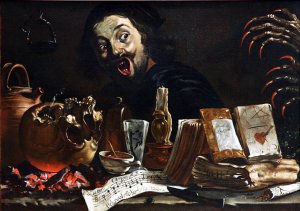 Magic Scene With a Self Portrait, Pieter van Laer (1630s)
Magic Scene With a Self Portrait, Pieter van Laer (1630s)
Self-portraits were traditionally done in a style that was still or posed. Not active. Here, we see Pieter *very* active. Eyes wide in a near comical fashion as he runs for the hills only to be stopped by the edge of the canvas.
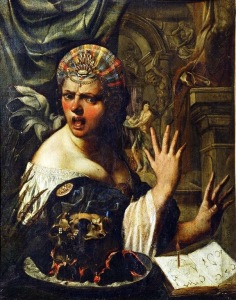 The Necromancer, Angelo Caroselli (1620’s)
The Necromancer, Angelo Caroselli (1620’s)
More than just the humor mentioned above, there is also the added level of comedy of the juxtaposed young practitioner in the foreground and the old one in the back. “The enscription CRUDELTA on the entablature ….[follows] the tradition of Cruelty as a violent woman harming babies…..a woman who drowns a baby or laughs when seeing a burning house with bleeding babies inside.”2 The humor here is of a level that the comedy in the foreground is to reverse the horror provoked by the old witch.
-
Indiana University. Witches on Top: Magic, Power, and Imagination in the Art of Early Modern Italy. By Guy Tal. N.p.: ProQuest, 2006. 57-60.
-
Ibid
It’s only a paper moon – Lunar omens in Judaism
A genizah (or geniza; Hebrew: גניזה “storage”; plural: genizot or genizoth or genizahs)[2] is a storage area in a Jewish synagogue or cemetery designated for the temporary storage of worn-out Hebrew-language books and papers on religious topics prior to proper cemetery burial. – Wikipedia
In the Cairo Genizah (a storehouse in Cairo, Egypt) a collection of documents and books dating from 870 CE exist. These writings deal with the Jewish Middle Eastern history and culture of the times. Within the collection can be found Targumic poetry. Targum is the spoken paraphrases and lessons of Jewish scriptures spoken in the common language of the people of the time. In this case, Aramaic; a language that existed in varied forms between 1000 BCE to the 13th century CE in Central and Eastern Europe and the Middle East.
One Targumic poem from the early centuries of the CE dealt with lunar observations and their omens.
The text of the poem is intended to be recited in the month of Nisan (30 days broken up between March-April in the Gregorian calendar) on the occasion of the revering/sanctifying of the new moon.
The poem contains seventeen omens, all lunar, five of which may occur on any day of the year. The remaining twelve are specific to a particular month, beginning with Nisan and ending with Adar. There are three types of lunar phenomena mentioned: the position of the moon’s horns at first sighting, the moon’s color, and when it is eclipsed.
Page 1
1. The lookout to raise his eyes, and survey the moon (the circle). For if when
2. it rises, its horns are even, then the world is in danger.
3. Now if you see the moon pointing southward, and its other horn
4. inclined to the north, then that shall be a sign for you: beware
5. of evil. for from the north oppression shall come forth.
6. If the moon was seen pointing to the north, and its other
7. horn inclined to the south, there will be great rejoicing in the entire
8. royal court. There will be cheap prices and abundance in the world.
9. The sign of the moon inclined to the south is good: the year will be bounteous,
10. with abundance in the world. If its (the moon’s) face is green in the north,
11 there will be inflation and famine in the world. If it is eclipsed
12. in the middle of Nisan, many men will go forth from the Sanhedrin (i.e., be executed?)
Page 2
1. May this ever be a trusty sign for you, that in it [Nisan] the pure animals
2. will be consumed (in a raid?). If it is red like blood
3. in lyyar, a king from the north will vanquish his colleague.
4. A great fire will fall upon mankind, and all
5. people will be smitten for [their] sin. If it is red and eclipsed
6. in Sivan [May-June], there will be confusion among those who go out
7. to sea. And orders will be issued against caravans
8. and wild beasts, for them to be killed. If its face
9. is green (during Tammuz [June-July]), there will be misfortune/ a great storm
10. (on the high sea). There will be a great outcry by every pregnant woman,
11. not from pangs of labor; they will go to death. If it stands
12. [up]right, and is eclipsed in the midst of the month of Av [July-August], there will be death
Page 3
1. in Egypt, and famine in the south; for the Nile will
2. be dry, and will not rise. And all the sons of Arabia will hunger
3. for bread.
** Translation provided by Profs. Jonas C. Greenfield, Stephen A. Kaufman, and Michael Sokoloff of Cambridge University. (c. 1990)
Divination in Judaism – A Disclaimer
My previous posts on this blog dealt a lot with how divination and magic pertained to Christian life, be that Catholic, Church of England, Lutheran, Huguenot, Anabaptist, etc. And whenever I sad the Church, it was intended to refer to the Catholic Church.
However, they were hardly the only religion and culture that existed in the Middle Ages. Before all of these were Judaism and they had their own consideration regarding the foretelling and the practicing of magic and the battling of demons.
There is so much that exists in this religion and culture that I’ve had to strictly limit myself on what I can look at otherwise I would never come up out of the rabbit hole.
First, I need to keep it to Europe and the Middle East going no later than 1603 (The death of Elizabeth I). This is the exact same boundary I use for all of my studies of divination therefore keeping everything similar. If I find in my research I should extend the timeline a small amount to accommodate an event or a discovery that is pertinent to my research then I will, but I will not go beyond 1650.
Second, I will not be going in depth into the Kabbalah. It is a school of thought that exists within Judaism. It is intricate and specialized and I don’t have the time to properly dedicate to it. That’s not saying I won’t refer to it or note when there is influence or cross over of it in my writings involving Jewish or Christian practices, but please don’t expect me to do full articles on Kabbalah and its details.
There are some articles on divination in Judaism coming up and I wanted to post a disclaimer ahead of the postings.
Thank you.
A chartula by any other name…….. (Part 1 – the History)
In going through my research for the period prosperity talisman that I discussed in my last post, I came across the reference to an object called the Chartula of St. Francis of Assisi.
St. Francis was an Italian Catholic friar who lived in the late 12th/early 13th century. Many know him now as the patron saint of animals and the environment. He was an individual who felt greatly with passion his religion, the teachings of the Bible, service to the community and the poor.
It was part of this great devotion to his faith along with his writings that spurred a number of interesting tales of the friar. It was said that he could drive demons away just by the very sound of his voice. He was known to communicate with all the animals of the world when he encountered them. He received the stigmata, which is described in the earliest written account of such.
This last miracle is what leads into my subject of the post, the Chartula.1
St. Francis received the stigmata in the Fall of 1224. The account was recorded by his dear friend and secretary, Brother Leo. Shortly after that incident, Francis felt the need to craft a gift for Leo. It was a protective amulet that he then instructed Brother Leo to fold up and wear on his body at all times. “accipi tipi chartulam itam et usque ad diem mortis tue custodias diligenter”2
This simple act is important for a very particular reason.
It is a solid example of not only the use of a talisman being used by a church man, but accepted as more or less normal. This is understood better by examining writings of contemporaries of St. Francis regarding the nature of talismans and it’s place in the work of God.
In 1266, the Franciscan friar and philosopher, Roger Bacon, created at the request of Pope Clement the IV the Opus majus. In this work he praises the use of textual amulets that utilize the words of God as it showed devotion by the user. told of a time when a shepherd fell into seizures while in the field. A young boy happened upon him and immediately put together a talisman to stop the affliction. The boy tied the talisman to the man’s wrist and instantly the seizing ceased. Bacon reasoned that the talisman worked due “to God’s grace, and not demons, because the boy’s motive had been blameless, free of deception, and thus worthy of divine intervention and blessing.”3
St. Thomas Aquinas in his writings, Summa theologica, condemned astrological talismans as demonic yet allowed talismans that were based on Christian texts.
A century before, there is a well documented account of Hildegard of Bingen crafting a textual amulet to be used to staunch blood.
The Chartula of Assisi is a piece of parchment approximately 5 1/2″ x 4″. On one side is written the Laudes, or praises of God along with brief quotes of scriptures; the other side had written a 5-line benediction chiefly quoting Number 6:24 – 26. Below that was a drawing of a Tau cross on a small mound (assumption is that it is supposed to be Golgotha) with the head/skull of Adam beneath it.
The more refined red writing is that of Brother Leo himself providing small notes about the piece such as the text was written on such a date by Francis, etc.
Upon creating the piece, St. Francis told Brother Leo to take the talisman and to wear it on his person for the rest of his life hoping that it would protect his friend from demons and any attacks, physical or mental. By all accounts he did and upon Brother Leo’s death, the Chartula was preserved in a reliquary and maintained as a focus for prayers, pilgrimages, and at least one exorcism.
When I found out about this amazing artifact, it was something I decided I could actually try and recreate. By doing so, I might be able to better understand some of the thought process that went into it.
The recreation of this piece will be in Part 2.
1 Latin word being the diminutive of charta (paper). Essentially a card or small piece of paper.
2 Don C. Skemer, Binding Words: Textual Amulets in the Middle Ages, 2006, Pennsylvania State University Press, Pg 176
3 Don C. Skemer, Binding Words: Textual Amulets in the Middle Ages, 2006, Pennsylvania State University Press, Pg 62
Could you pick them out in a crowd?
There’s a great quote from the 1991 movie, The Addams Family, where the daughter, Wednesday, explains her Halloween costume (or lack there of in this case):
“I’m a homicidal maniac; they look just like everyone else.”
Something that I deal with on a regular basis when I am teaching classes on the subject of historical divination or even when just having a conversation on the topic is the misconceptions that folks have about what soothsayers/oracles/diviners are, what they did, and how they functioned in society.
Interestingly enough, one of the most common beliefs is that these historical figures were no more than decrepit hags hidden in some hovel on the edge of town where they kept a menagerie of creatures with them and that you could instantly tell who and what they were just by their appearance.
Hardly.
The above mental image is credited to the imagination of 18th century authors working with the now established stereotype of the gypsy fortune teller and embellishing it a tad lot. Also, thanks to Hollywood, we now have this image thrown around the world in any number of movies over the last 90 years.
However, the truth is that the diviners of the middle ages and renaissance were everyday people. They were scientists and priests, housewives and doctors, constables and merchants.
When regarding depictions of individuals who are cited as being seers or oracles or diviners from the 11th century to the early 16th century in Europe it becomes quite clear that physical appearance had little to do with identification.
Through out the first half of the 2nd millennium (1000 BC to 1600 BC) in Europe, depictions of seers and diviners and oracles were fairly mundane.
Let’s check out one of my favorite characters, the Witch of Endor. In the Bible (1 Samuel 28:7) we are introduced to her by way of a brief scene where she raises the ghost of the prophet Samuel to speak to King Saul. No where in the book is there a physical description of her save that she is a woman. This absence of an image gave artists and engravers free reign on how to depict this amazing person. Below is one of those images.
An illumination from a manuscript that shows the witch. She is dressed nicely and in the style of the period. Nothing about her depiction suggests that she is a mystical character of any fashion. We only know who it is in context with the document.

“Cimmerian Sibyl” by Ludger tom Ring the Elder, early 1500s.
Other oracles and seers from the ancient world such as the Sibyls were depicted in two different ways; either in “classical” dress (which seem to be the same type of dress that most of the ancients were shown wearing be them mystical, literary, or common folks), or in contemporary dress of the artist.
As a last example for this post is an image that shows individuals performing different form of divination including necromancy, haruspicy, hydromancy, and astrology. They all look like everyday people from most any town. The only thing that is telling are the different props they are holding or activities they are doing.
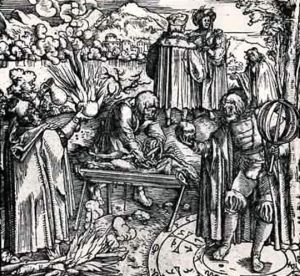
“Scenes-Of-Divination,-Including-Haruspication,-Pyromancy-And-Necromancy” by Hans, the Elder Burgkamair 1516
It was only with the influx of the immigrant “Gipsies” from India in the 16th century and the propoganda in art regarding them that we suddenly have a form of dress associated with a form of divination, but even then, it was specific to the immigrants and not to Europeans. They continued to be shown in a cleaner and more proper appearance.
So, as always, come and find me at an event and I’ll be happy to do a reading for you. I’ll be easy to spot. I’ll look just like everyone else.
